In wrapping up last week’s article, I finished with the comment that I would not want to be the Duke football team the next weekend. Heck, I wouldn’t want to be the Duke football team any weekend, but that is beside the point. Simply put, I did not see any way that the Hoos were going to return from Laramie and then lose to Duke. And it didn’t happen, as expected.
Still, the Duke game was not without its speedbumps for UVa, and I think the team and the staff still has a lot of questions to answer going into this week’s match-up against UNC. But before we look forward, we will start by looking back.
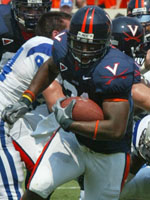 |
|
Seeing fullback Rashawn Jackson carry the ball was a good adjustment to the offensive schemes. |
1. Some steps in the right direction. Leaving Laramie, there were screams from the message boards – many well-deserved – about the adjustments that UVa had to make to improve its production on both sides of the ball. Giving credit where credit is due, Hoo fans saw several such adjustments this weekend against Duke, some to the schemes, some in production, and some at an individual level. Let’s take a look at one of each.
My favorite adjustments to the schemes, without a doubt, were the much-needed tweaks to the running scheme. More runs in between the tackles – though we still outsmarted ourselves a couple of times – and a lot more reps for the Rashawn Jackson at fullback resulted in a career day for Cedric Pearman and a much more effective day on the ground (of course, the bar had been set pretty darn low). Hopefully we have found something we now can start to build on when it comes to running the ball.
There were important adjustments on defense, too. Going into the Duke game, the staff knew that the team had to improve on its third down defense and, by doing so, get the defense more rest and the offense more chances. After handing Wyoming third down conversion after third down conversion, some scheme adjustments had to happen but more than anything, the defense simply had to make some plays on third down. And they did – the Hoos managed to stop Duke on its first five third down attempts, and allowed only 5 conversions out of 19 attempts on the day (8 of 24 if you add in the fourth down attempts). As a result, UVa managed to win the time of possession battle after being abused in this department last week.
At an individual level, the best adjustments I saw from week 1 to week 2 were by Jamaal Jackson , who got more than his fair share of grief after a rough start to the season in Laramie. Jackson played the pass with much more confidence in week 2, and I admit that I was out of my chair quickly to applaud his pass break-up on third down late in the first quarter. Jackson also played the run with his customary aggressive attitude and contributed some decent shots. Do I still think Jackson is a linebacker trying to get by at safety? Yes. Did Jackson do a very solid job getting by at safety this week? Heck, yes.
2. Breaking down Lalich’s day. At this point, I have no doubt that the great majority of Hoo fans are chomping at the bit to see Peter Lalich as the starting quarterback, and there is no question that Lalich flashed a lot of talent on Saturday. But not surprisingly, there were plusses and minuses to Lalich’s performance.
On the plus side, I think the most impressive aspect of Lalich’s appearance was the poise he showed on the field, both in running the offense – he certainly has command of the playbook – and executing the plays. Lalich simply does not look to be intimidated at all by the prospect of playing. I was particularly impressed by how Lalich converted three third downs during his touchdown drive to start the fourth quarter, though a third down conversion on a drive that did not result in any points might have been his best of the game. On 3rd-and-10 with about six minutes left in the game, Lalich did an excellent job standing tall in the pocket and staring down the blitz that was coming at him, giving Tom Santi the time he needed to bring his route across the formation. As a young quarterback, Lalich is going to see plenty more of the blitz in upcoming weeks (Tenuta’s defense is only two weeks away). If he can handle the blitz as well as he did on this play, Lalich will be just fine.
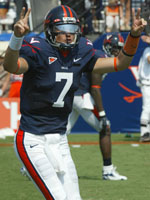 |
|
Peter Lalich showed a lot of poise on Saturday against Duke. |
But despite Lalich’s solid production and surprising poise, I did have a couple concerns coming out of the Duke game.
Chief among my concerns was the fact that Lalich’s mechanics broke down on occasion. Lalich is never going to be a guy that throws with a classic over-the-top motion, but he does need to throw from a consistent slot if he is going to be able to throw with accuracy and touch. In high school, Lalich had a tendency to start slinging the ball from the side when he was rushed or when he was trying to get a little extra zip on the ball. Lalich has worked extremely hard to tighten his mechanics, even going so far as to hire a quarterback tutor for offseason work. But what does Lalich do on his first drive, when he is trying to fire in a ball on third down? He drops into almost a sidearm delivery.
His slot also was a bit shaky at times in the second half. On the touchdown drive, for example, Lalich overthrew Stupar in the end zone on 1st-and-10 from the 15-yard line in large part because he dropped his arm angle on the throw. When that happens, the flight of the ball tends to be pretty flat, making it very difficult for Lalich to drop a ball over the defenders like he had to on that throw.
Generally, Lalich is a very accurate passer, and he often will make some great passes when slinging the ball, a good example being the bullet pass Lalich completed to Jon Stupar on a crossing route to set up the field goal at the end of the first half. But completions like that one tend to encourage bad mechanics, and bad mechanics almost always come back to haunt a quarterback in the end. Thus, Lalich is going to have to stay consistent in his mechanics if he is going to avoid the occasional sloppy throw (and occasional sloppy throws can turn into occasional interceptions).
Lalich also is going to have to improve at looking off a defense. The problem is not that Lalich is only going to throw the ball to his first read. In fact, Lalich will work through his progressions better than most young quarterbacks, as the dump-off to Keith Payne for a first down showed. But Lalich did flash a tendency to stare down his first read, something that he got away with against Duke but will not get away with versus defenses like Georgia Tech or Virginia Tech for a couple of reasons. First, Lalich is going to give defenders great jumps on the pass as long as he is telegraphing the throw. Second, Lalich has to know where the safeties are before he throws the ball, and he does not have the foggiest idea where the safeties are when his eyes are only tracking the receiver.
Lalich clearly has a ton of potential and a great presence on the field. But he does need to tighten up his game if he is going to be able to take it on the road and against better opponents.
3. “Special” teams? Simply put, that may be the worst game I have ever seen in terms of special teams execution. At least, the worst I have seen above the pee-wee level.
Let’s go through some of the gaffes:
- Three missed field goals by Duke.
- Mediocre kickoff coverage by the Hoos.
- UVa has a chip shot field goal blocked due to a bad snap (a minor problem) and awful blocking (the real problem – see below).
- Two more bad snaps by Danny Aiken resulting in a safety on one play and excellent field position for Duke on the other.
- Lousy lane discipline in punt coverage by Duke allowing Vic Hall to break off a big return.
- A fumble by Andrew Pearman on a kickoff return.
- Ryan Weigand had a punt blocked.
And these are just the obvious ones. If I start going through the missed blocks, the missed assignments, and the missed tackles, I am going to have to insist that Kris start paying me by the word. But at this point, I think the best thing to do is look forward and determine how to fix the mistakes. For the most part, I think the mistakes will be easily addressed. Chalk the fumble up to a dumb decision to try and cutback across the scrum and an awkward collision with Brandon Woods , and we will give Pearman a mulligan on that one. The kickoff coverage also should be easy to fix with some time in the film room and a little more air under Chris Gould ‘s kickoffs.
In some ways, one of the easier problems to fix was the worst of the game – the long snapping. No question that Danny Aiken could not have had a worse day (unless the staff had continued to let him snap). But there are two ways this problem can be fixed. First, Aiken can let the memory of an awful game go, as I think that is all that stands in the way of Aiken bouncing back – his mechanics are just too darn good, though he did get loose with his mechanics this Saturday. Second, if Aiken cannot bounce back, Crutcher Reiss provides a decent back-up option. The only problem there is that Reiss does not snap with the same velocity as Aiken, something that probably contributed in some small way to the punt block late in the game.
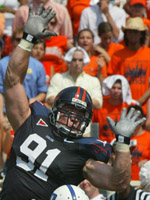 |
|
Chris Long had a strong outing despite a small mistake on special teams. |
The blocked field goal also should be easy to fix, if for no other reason than the fact that Chris Long almost never makes the same mistake twice. Obviously the snap can be better, but Vic Hall did a good enough job getting the ball in the right position in time for Gould. The real problem on the play was the sin of allowing a defender to jump an inside gap. It might have been Chris Long ‘s only mistake on the day – he received a well-deserved game ball – but it was a mistake nonetheless. When trying to block a field goal try, the defense frequently will try to overload one side of the formation and create a gap somewhere for a sprinter to go after the block. The line combats that with a simple philosophy – block in. In other words, no matter what, don’t ever allow anyone to penetrate the gap to your inside shoulder.
Chris Long lines up as the widest blocker in the formation so in his case, not allowing an inside rush means that a defender may get to run wide and sprint for the kick block. At most, Long should extend his arm outside to force the defender as wide as possible. But if the timing of the kick is good, the outside sprinter is never going to get there in time. And he didn’t on this field goal attempt either … but the next guy inside did. On the snap, the UVa lineman who lined up inside Long had to stop penetration on his own inside shoulder – his primary responsibility – so Long had to decide between blocking the inside rush or the outside sprinter. The correct block is to the inside, with Long also extending his outside arm to force the outside sprinter to go as wide as possible. But instead, Long tried to arm block both defenders, and actually engaged more to the outside than the inside. As a result, the inside defender jumped the gap and made the block. But don’t expect Long to ever make that mistake again.
The one gaffe that causes me the most concern is the blocked punt. Weigand had another good day in terms of the distance on the punts with which he connected, but I long have had concerns about his timing. It seems to me that Weigand is a bit too deliberate in his steps on his best punts, and struggles in a big way with the consistency of his punts when he speeds up his steps. On the punt block, Weigand took a full three steps, and he did not do so with a lot of pace, allowing the outside sprinter on Duke’s line to come outside and make the block. Going forward, I suspect that opposing coaches will be scheming to try to get to another Weigand punt.
4. An almost play. Third quarter. Duke has the ball after Mikell Simpson ‘s fumble, and faces a 3rd-and-3 on UVa’s 34-yard line. Duke ends up calling a timeout with the play clock winding down. After the timeout, Duke manages to convert on the third down with a pass that picks up 16 yards, but three plays later Jon Copper makes an interception to end the drive. So why do I mention the earlier third down play? Because I think the Devils had a great chance to get into the end zone on the play – or at least get close – if they had not run out the clock.
On the first third down attempt, i.e. prior to the timeout, Duke had a tight formation with a seven-man line, an I-formation in the backfield, and a tight wide receiver on the short side of the field. UVa countered with a tight defensive formation, with Mike Parker lining up just outside Denzel Burrell ‘s hip on the wide side of the field. Just based on what Duke showed in its initial steps before the called timeout, I think that Duke was planning to run a wide receiver reverse to the wide side of the field – and with Parker playing tight and Burrell stunting to the inside of the tight end on the snap, I think the play would have been there.
Perhaps the play would have failed anyway. Perhaps Chris Long would have gotten such deep penetration on the snap that he would have forced the wide receiver too deep in the backfield and stretched out the play. Perhaps Mike Parker would have recovered quickly and found a way to make the play. Perhaps one of UVa’s safeties would have read the play perfectly and made a great play coming up the field. Perhaps the handoff would have been muffed. But the simple fact is that Duke appeared to have the right play called against the right defense … and got zip out of it. In a game like this one, where UVa was making plenty of gaffes and the opportunity to win on the road was there, I think this one play nicely sums up why Duke continues to lose game after game after game.
5. The play you look forward to in film study. On almost every play, there is something that a coach can find to criticize. After all, it is not often that 11 players on the field each accomplish exactly what they are supposed to accomplish when the play was drawn up on paper. But every once in a while, there is a play that the kids on the team know is going to baffle even the most critical of coaches. Cedric Peerman ‘s 58-yard touchdown run in the first quarter was one such play.
To avoid missing the obvious, the discussion has to start with Peerman, who ran the play aggressively and lost little speed on his cuts. But Peerman also did a good job setting up his blocks, and there were a series of excellent blocks from the line of scrimmage all the way down the field. In fact, if you look at all nine of the players with blocking assignments on the play, you will find nine guys that did exactly what they were supposed to do.
Peerman got through the line cleanly, for example, because of a pair of solid blocks by the tight ends. On the play, Tom Santi was lined up off the line of scrimmage on the hip of Jon Stupar, who was lined up at tight end on the left side next to Eugene Monroe . Before the snap, Tom Santi starts to motion to the right side and then drifts back over Monroe. By doing so, Santi now has the angle he needs on the crossblock against the Duke OLB. At the snap, Stupar comes off the ball to his right, hitting the defensive end and sealing the line effectively, while Santi comes off his butt to kick the OLB out of the play, opening up the hole for Peerman. Both did a good job on their blocks, opening up a hole for Peerman that even Chris Horne could run through.
Those are the easy blocks to see at the line of scrimmage, but other blocks from several linemen that were just as important to springing the play. To understand those blocking responsibilities, the first thing you have to remember is that on the snap, Ian Yates-Cunningham pulls across the line and leads into the hole in front of Peerman. IYC eventually makes an excellent downfield block against a defensive back that was obvious for all to see, and he has to get a lot of credit for executing that block as plenty of linemen will whiff on the same block when running at full speed. But to understand the play, you also have to understand what is happening behind IYC as he pulls because once IYC leaves the line, he opens up a hole for the defense and gives the defense a chance to run the play down from the backside. The defensive end that was lined up just outside of IYC, for example, has a clean look at Peerman in the backfield once IYC pulls, and no one has a good angle on him to try and make the necessary block. There are two ways to address that problem. One is to check out of the play at the line. The other is for the line to work together to cover the gap, and that is exactly what happened.
At the snap, Will Barker does not have the angle on the defensive end to block him without holding since Barker is on the defensive end’s left shoulder for a play going to the defense’s right. So what Barker does at the snap is shove the defensive end with his left arm, pushing him far enough to the left to allow Jordy Lipsey – who does have the necessary angle – to engage the defender and make the sealing block. Without that shove, the defender likely can split the gap before Lipsey can slide over. Barker then does one better, getting back to his right to shove Duke’s Patrick Bailey deep into the backfield, forcing him too deep to catch Peerman from behind before Peerman has the chance to accelerate. As far away from the excitement as Barker is, his two blocks are almost never going to be noticed by the fans in real time. But if he does not make those blocks, there is a good chance that either the defensive end or Bailey makes the play on Peerman in the backfield.
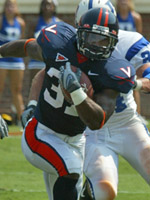 |
|
Cedric Peerman ‘s 58-yard TD featured a lot of great blocking. |
The other linemen also make solid blocks on the play, each covering his responsibility perfectly. Like Barker, Lipsey gives the Duke nose tackle a good chuck before peeling off and picking up the defensive end from Barker. In a block reminiscent of the Barker/Lipsey hand-off discussed above, Branden Albert then picks up the block on the nose tackle that Lipsey chucked, and Albert proceeds to hold the block long enough to keep the opposing lineman from having any realistic pursuit angle on Peerman.
With Stupar having sealed the defensive end lined up over Eugene Monroe – and not a lot of tight ends are going to neutralize a defensive end as easily as Stupar did – Monroe’s job is to get to the second level and block a linebacker; in this case, the inside linebacker who has the cleanest line at Peerman. On top of that, because the Duke inside linebacker starts to slant right on the snap, Monroe did not have much of an angle for the block. In fact, a lineman often will be called for a hold in this situation as he tries to keep the linebacker from sliding off into the hole. But Monroe avoids a flag, instead hitting the linebacker with enough authority to knock him off balance just long enough for Peerman to sprint by untouched.
Once Peerman gets to the second level, IYC’s block mentioned above and the blocks of two wide receivers are key to springing Peerman. When it comes to those two wide receiver blocks, one is obvious on the play, one less so. Staton Jobe ‘s block is the obvious one, as he made a solid block around the 20-yard line to give Peerman the sideline. The less obvious block is the one by Maurice Covington nearer to the line. But what impressed me about both blocks was not the blocks themselves – it was how the wide receivers got themselves in position to make the blocks.
Take Jobe’s block for example. The run by Peerman was down the left sideline. But Jobe started the play lined up outside the numbers on the right side of the offense. In other words, to make the block that the TV cameras ultimately picked up, Jobe had to get from outside the numbers on the right side of the field to the outside of the numbers on the left side of the field, and then block back to the right. Given how fast the play developed, Jobe had to absolutely fly across the field to be in a position to do anything other than clip. The block he ultimately executed was good – and Peerman did an excellent job of setting up the block to allow Jobe to make the block without clipping – but the hustle was fantastic.
Covington’s block was easier to overlook, but no less of a challenge to execute. Covington was lined up on the left side of the offense, just inside the numbers. The opposing Duke cornerback was lined up on Covington’s inside shoulder about nine yards off, meaning that Peerman’s run was coming right at him and Covington had a lousy angle to try and make a block. But at the snap, Covington takes a good angle toward the hashes and is able to get his body planted in between Peerman’s lane and the Duke cornerback. He then does a very good job staying light on his feet and keeping that body position, never giving the Duke cornerback a shot to make the play.
On the play, Jameel Sewell makes a clean hand-off, Peerman makes a great run, and the other nine Hoos on the field make exactly the block they are supposed to make – and maybe one or two that they shouldn’t have been able to get to, absent a lot of hustle. For this one play at least, film study cannot get here fast enough.
6. Things I liked this weekend.
- Watching the fullback carrying the ball again in UVa’s offense.
- Watching Chris Long move laterally.
- Jon Stupar’s diving catch to get the ball rolling on the last touchdown drive – the play of the game in many ways.
- Clint Sintim ‘s under move on his sack.
- Duke’s use of the draw in the first half.
- UVa’s adjustment on the draw in the second half.
- Cedric Peerman ‘s reads in picking up the blitz.
- Keith Payne ‘s stretch for a first down to keep a touchdown drive going.
- Duke’s adjustment to flood the box early in the third quarter to try and force UVa to the air.
- Watching Jameel Sewell step up and greet the offense with high fives after Lalich’s touchdown drive.
- Mo Covington’s downfield blocking.
 A banged up Tom Santi running tough to get in for his first touchdown reception of the year.
A banged up Tom Santi running tough to get in for his first touchdown reception of the year.
7. Things I did not like this weekend.
- The booing.
- Andrew Pearman still not making the first guy miss on punt returns.
- The second-and-goal decision to run away from Monroe and Albert, resulting in a loss on the play.
- Jameel Sewell again failing to get enough air under the deep ball.
- How Rashawn Jackson was carrying the ball in one arm and away from his body on a couple of his runs.
- Empty seats for a home opener.
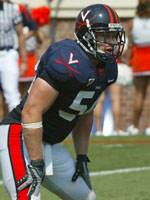 |
|
Jon Copper’s sack on Saturday was well executed. |
8. A special day. Mike London has set a 36/36 goal for the defense. Jon Copper looked like he was planning to have a 36/36 season himself with his play on Saturday.
Copper is never going to be the fastest linebacker on the defense, but he looked like he was shot out of a cannon (relatively speaking) on his sack of Lewis in the second quarter. The play was a study in how a defender can play faster than his feet would seem to carry him, as Copper diagnosed the play quickly and took an aggressive angle through the blockers as soon as he saw a gap. On top of that, once Copper picked his gap, he hit it so quickly that he was able to split two linemen, both of whom reached for Copper on his way by. And Copper finished off the play by making the tackle in a sprint, a tackle that some blitzers fail to finish.
Copper’s interception in the third quarter also was a big play for the defense and an interesting pick to breakdown, one of the few times where you will see a quarterback get burned by holding the linebackers on play action. On the snap, Duke faked the draw play that had been so effective throughout the first half. That had the excepted result of holding the linebackers, and Copper even took a couple of steps toward the line of scrimmage. At that point, Lewis is looking down the field to his wide receiver who is starting to cut inside the hashes, and I don’t think Lewis ever saw Copper coming out of the box to make a late drop into his underneath zone. When Lewis then failed to put much air under the ball, it was there for the taking for Copper, who still was in the process of trying to get deep in his zone. If Copper gets into his zone quickly on the play, odds are that Lewis sees him and checks off to another receiver (and if he didn’t, the pass might not have been completed regardless, as Clint Sintim did a good job getting as deep into his zone as the wide receiver did in the same amount of time).
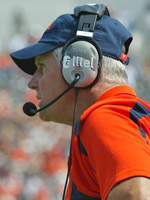 |
|
UNC is a big game for UVa coach Al Groh. |
9. Another critical game. I did not think we were going to lose to Duke, and we didn’t. But I am not sure that many outside observers gained a different appreciation for this UVa team after the 24-13 triumph over Duke. Simply put, Duke is Duke, and you are supposed to beat them – heck, everyone is supposed to beat them – particularly at home.
But now UVa has to venture back on the road for a match-up against UNC in Chapel Hill. UNC is coming off a loss of its own and will be looking to bounce back in a big way.
There is not a poster on The Sabre that is not aware of UVa’s recent road woes, and nothing happened in Laramie to make anyone think that anything has changed. Maybe the altitude was a big factor, but the simple fact is that fans saw nothing to give them hope.
Plus, Virginia goes into the game in Chapel Hill with a very uncertain rotation at quarterback between two young players, neither of whom has proven that he can handle the pressure of a big game on the road. Butch Davis and Chuck Pagano are going to be looking for ways to rattle UVa’s quarterbacks early and often while still keeping the box loaded to force UVa to open up the field with the pass. As a result, Mike Groh and the offensive staff will have to come up with a plan to establish the pass early without putting the quarterbacks in a position to make the big mistake. That is not an easy equation to solve but it is an imperative, as Cedric Peerman and the backs are not going to be able to accomplish much against the 8-in-the-box looks that the UNC defense will give them until UVa shows it can make the defense pay for those sets.
I hate the “must win” tag – it is used far too liberally. But if Virginia loses against UNC, it is then 1-2 and facing a very tough home game against Georgia Tech the next weekend. Lose that game to go 1-3 out of the gate and the attendance figures will be closely watched for the Pitt game on Sept. 29. In other words, “must win” or not, the UNC game is huge.
10. Random thoughts.
- Who would you rather be today, Lloyd Carr or Al Groh? Discuss.
- I think Chris Cook would be an All-American safety in a heck of a lot of defenses, including ours.
- I have no idea why I take such pleasure in watching Notre Dame lose football games, but I really, really do.
- The UVa staff has to improve the situation at Westfield – that school is going to be churning out D1 prospects year after year after year – and hopefully we took a step in the right direction with the recruiting of Mike Glennon this year.
- Dontrelle Inman has star written all over him.
- My golf game is on life support.
- Nice to see Green Run winning some football games again.
- As hard as Andrew Pearman got hit on his last kickoff return of the third quarter, was I the only one to notice that it was the Duke player who ended up on his rump with his mouthguard flying through the air?
- Weekly update on my sons’ football teams – older son’s team wins, younger son’s team has a bye week.
- Expect to see Ras-I Dowling’s snaps increase significantly over the course of the season.
- My Chicago Bears need to find a spark on offense. Bad.
- Cedric Peerman is one of those kids on the team that you have to be thrilled to see have a big day.
JHoo’s “10 Things I Learned” column is scheduled to appear on Monday evenings throughout football season. The column is an example sample of what subscribers get with their Sabre EDGE subscription. Sign Up Today!



